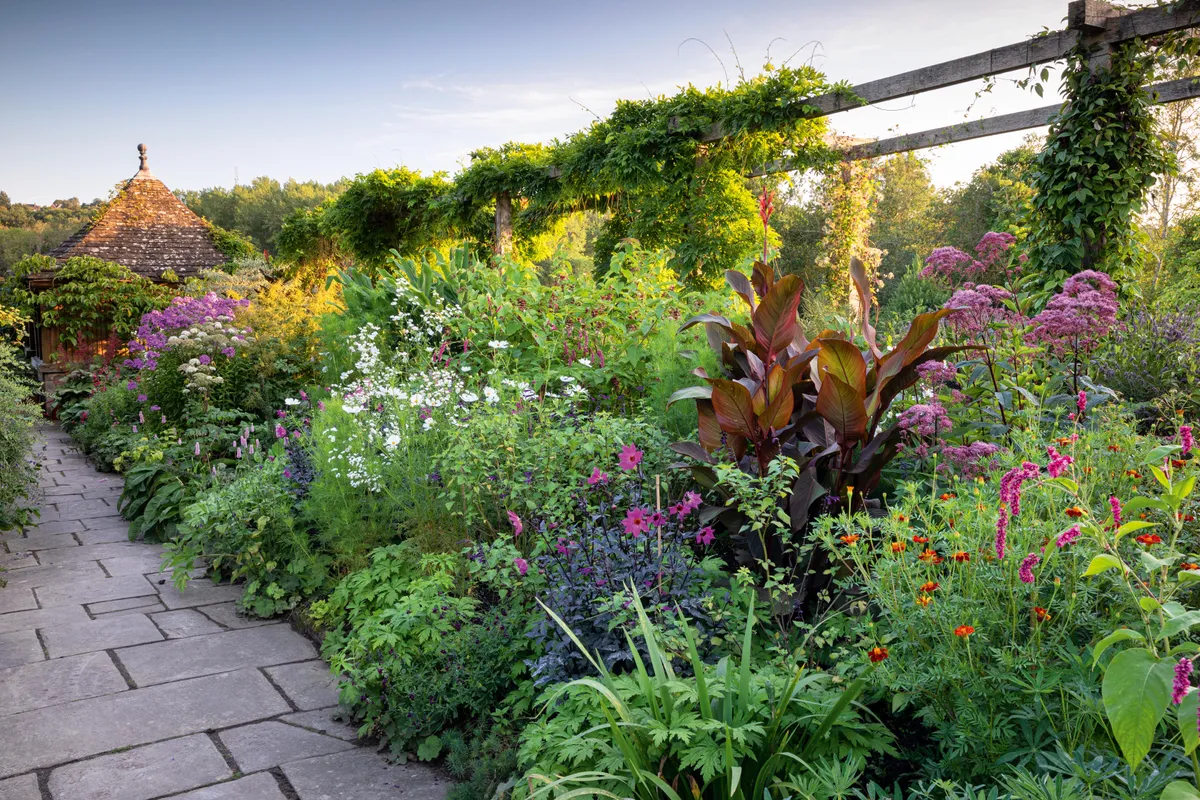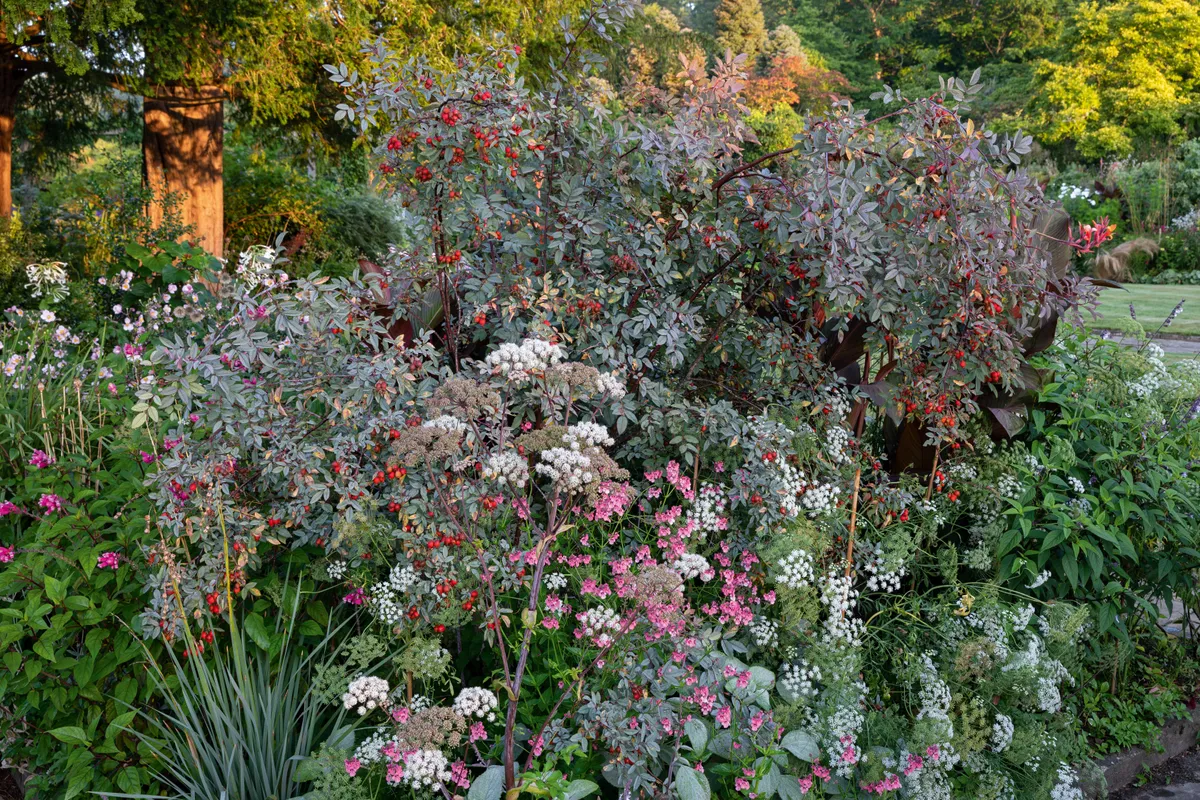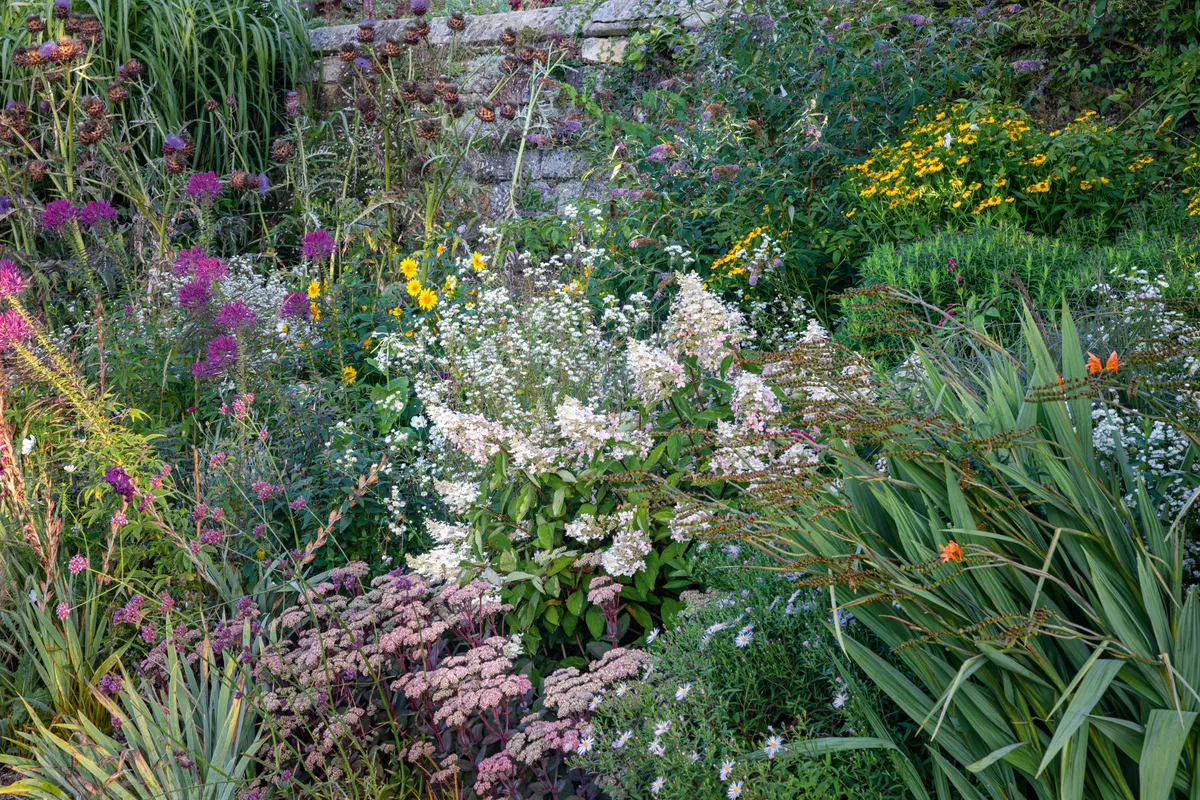Show must go on
Successional planting is the secret behind this Summerhouse Border designed for as long a season as possible. Spring bulbs and annuals start the display, then as they fade they’re engulfed by midsummer perennials, such as Geranium psilostemon, which we cut back in mid July as the display gets tired. At this point we interplant late summer annuals, such as Cosmos bipinnatus ‘Purity’, and tender perennials such as dahlias. These completely transform the border, and complement later-flowering perennials such as eupatoriums.
It is a lot of work but worth it.

Plants included in the border
Phlox maculata ‘Princess Sturdza’ Probably my favourite phlox to use, with a beautiful flower colour and a long season of interest but best of all is its scent. 1.4m. AGM. RHS H6, USDA 3a-8b.
Persicaria bistorta A vigorous perennial that forms a low mound of pink drumsticks. 1.2m. RHS H7, USDA 4a-7b.
Cosmos bipinnatus ‘Purity’ One of the best white cosmos; its pure-white flowers have an almost floating feeling. The trick is to sow in April so plants are the perfect size when a gap is available mid July. 1.2m.
Geranium psilostemon Perfect for interplanting. Best grown through a pea-stick cage to stop it flopping. 1.2m. AGM. RHS H7, USDA 5a-7b.
Dahlia ‘Magenta Star’ A truly lovely dahlia with good purple foliage and stunning, single, magenta flowers. 1.1m. AGM. RHS H3, USDA 7a-10b.
Canna indica ‘Purpurea’ A vigorous and easy to grow canna, useful for adding structure at the end of the season. 2m. RHS H3, USDA 7a-10b.
Eupatorium maculatum ‘Riesenschirm’ A strong perennial with clouds of dusky purple flowers presented on dark stems. Can get quite large so best divided regularly. 1.8m. RHS H7, USDA 4a-8b.
Tagetes ‘Cinnabar’ Developed by Christopher Lloyd at Great Dixter, it is a vigorous deep-red marigold that flowers late into the season. 1.2m.
Persicaria orientalis Tall, arching annual with long, pink tassels that can thread its self through a planting. It will self-seed quite freely but is easy to weed out. 1.5m.
Dry shade challenge
The dark-green foliage of the yew tree at the back of this border is a perfect backdrop to the planting, but it creates quite challenging, dry, shady conditions. Rosa glauca is an anchor plant, and one of the loveliest roses in the garden. Its arching red stems are handsome in the winter and in June it has pretty, single pink flowers that in late summer are replaced by small red hips. I especially like planting pink flowers alongside it to show off the rose’s pretty pink petioles.

Plants included in the border
Anemone x hybrida ‘September Charm’Dry shade becomes a problem closer to the roots of the yew and anemones perform particularly well in this situation. They can spread quite quickly and so do need to be dug out once they threaten to take over. 90cm. AGM. RHS H7, USDA 4a-8b.
Rosa glauca A beautiful rose with year-round interest and especially useful foliage. We regularly prune out old wood at the base to encourage new handsome arching shoots. At Gravetye it self-seeds, producing some exciting hybrids. 1.8m. RHS H7, USDA 2a-8b.
Angelica sylvestris This is a native herb that we allow to seed through the borders. The flowers can unfortunately go brown as they go over but it adds an interesting structural element and the purple stems complement those of the rose. 1.5m. RHS H5, USDA 4a-7b.
Diascia personata This lovely plant has a wonderfully long season and is particularly useful in a matrix planting with grasses and other perennials. And it is perfect to scramble through foliage plants. It roots easily from cuttings and since younger plants seem to perform best it is best propagated regularly. 90cm. RHS H4.
Coleus argentatus Previously known as Plectranthus argentatus, this is a very useful tender perennial with silver foliage and blue flowers. Best propagated by cuttings at the end of summer and overwintered in a cool glasshouse. 75cm. AGM. RHS H1C, USDA 10a-11.
Ammi majus If sown in autumn and overwintered in a cold frame, plants can reach 2m and be in flower by early June. Later sowings can be smaller. 1.5-2m. AGM. RHS H6, USDA 7a-10b.
Spontaneous colour
This combination in the Long Border relies predominantly on hardy perennials and shrubs, using only a handful of annuals. We want our planting to make undulating contours along its length. In winter we review each clump of perennials, dividing where necessary, trying to space them so they will just knit together without crowding and competing. Weeding is a precise art, editing self-seeders, such as verbena, that add an element of spontaneity but must not be allowed to compete with perennials.

Plants included in the border
Cynara cardunculus Cardoons offer impressive foliage in early summer, followed by purple thistle that give pleasure through winter. Foliage dies back after midsummer leaving ugly legs that can be hidden with careful planting. 1.5m. AGM. RHS H5, USDA 7a-9b.
Cleome hassleriana ‘Violet Queen’ Interesting foliage and unusual flowers. A useful annual to add vertical accent and an airy quality to any herbaceous border. Its spider leg-like seedpods will dry and give interest into the winter. 1.2m. RHS H2, USDA 9a-10b.
Verbena bonariensis This famous self-seeder can be wonderful, but requires ruthless control. We remove old plants in winter and edit the young seedlings to allow just a handful to flower. 2m. AGM. RHS H4, USDA 7a-11.
Hylotelephium ‘Matrona’ An upright sedum that, unlike so many others, doesn’t collapse. Its purple leaves are borne on reddish stems and its beautiful pink flowerheads deepen in colour as they age. Always covered in bees. 75cm. AGM. RHS H7, USDA 3a-9b.
Aster pyrenaeus ‘Lutetia’ If I could grow only one aster it would be this one. It will start flowering in late July and looks fabulous throughout August making low mounds of pale-lilac flowers with yellow centres. It is also mildew free. 50cm. RHS H7, USDA 4a- 8b.
Hydrangea paniculata ‘Big Ben’ A good hydrangea I first saw on a trip to RHS Garden Wisely and immediately decided to use. The panicles open a pale green, fading to white then maturing to pink, but best of all is its strong scent. 3.6m. RHS H5, USDA 3a-8b.
Helenium ‘Riverton Beauty’ A tall and long-flowering, helenium that needs some support, ideally from a pea-stick cage, and benefits from regular divisions. 1m.
Crocosmia ‘Zeal Giant’ One of the tallest crocosmias, and a true stunner with brilliant-orange flowers that continues to look magnificent after flowering thanks
to its stately foliage and interesting seedheads. 1.5m. AGM. RHS H4, USDA 5a-9b.
